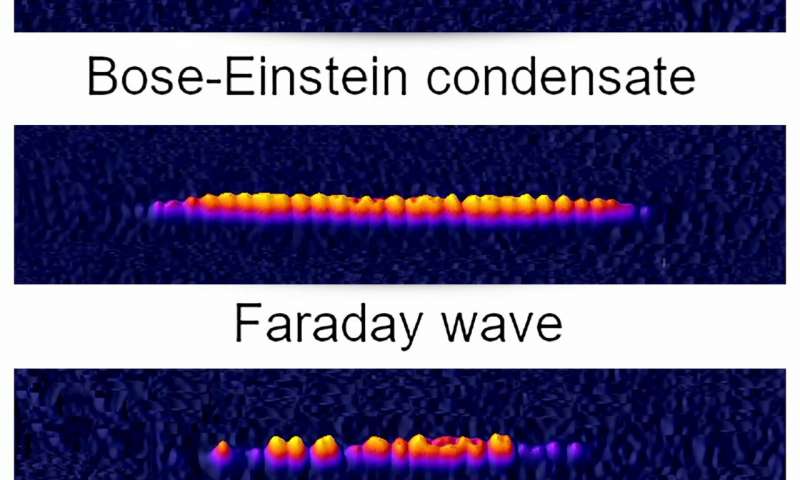
Physicists in the United States, Austria and Brazil have shown that shaking ultracold Bose-Einstein condensates (BECs) can cause them to either divide into uniform segments or shatter into unpredictable splinters, depending on the frequency of the shaking.
“It’s remarkable that the same quantum system can give rise to such different phenomena,” said Rice University physicist Randy Hulet, co-author of a study about the work published online today in the journal Physical Review X. Hulet’s lab conducted the study’s experiments using lithium BECs, tiny clouds of ultracold atoms that march in lockstep as if they are a single entity, or matter wave. “The relationship between these states can teach us a great deal about complex quantum many-body phenomena.”
The research was conducted in collaboration with physicists at Austria’s Vienna University of Technology (TU Wien) and Brazil’s University of São Paulo at São Carlos.
The experiments harken to Michael Faraday’s 1831 discovery that patterns of ripples were created on the surface of a fluid in a bucket that was shaken vertically at certain critical frequencies. The patterns, known as Faraday waves, are similar to resonant modes created on drumheads and vibrating plates.
To investigate Faraday waves, the team confined BECs to a linear one-dimensional waveguide, resulting in a cigar-shaped BEC. The researchers then shook the BECs using a weak, slowly oscillating magnetic field to modulate the strength of interactions between atoms in the 1D waveguide. The Faraday pattern emerged when the frequency of modulation was tuned near a collective mode resonance.
But the team also noticed something unexpected: When the modulation was strong and the frequency was far below a Faraday resonance, the BEC broke into “grains” of varying size. Rice research scientist Jason Nguyen, lead co-author of the study, found the grain sizes were broadly distributed and persisted for times even longer than the modulation time.
“Granulation is usually a random process that is observed in solids such as breaking glass, or the pulverizing of a stone into grains of different sizes,” said study co-author Axel Lode, who holds joint appointments at both TU Wien and the Wolfgang Pauli Institute at the University of Vienna.
Images of the quantum state of the BEC were identical in each Faraday wave experiment. But in the granulation experiments the pictures looked completely different each time, even though the experiments were performed under identical conditions.
Lode said the variation in the granulation experiments arose from quantum correlations—complicated relationships between quantum particles that are difficult to describe mathematically.
“A theoretical description of the observations proved challenging because standard approaches were unable to reproduce the observations, particularly the broad distribution of grain sizes,” Lode said. His team helped interpret the experimental results using a sophisticated theoretical method, and its implementation in software, which accounted for quantum fluctuations and correlations that typical theories do not address.
Hulet, Rice’s Fayez Sarofim Professor of Physics and Astronomy, and a member of the Rice Center for Quantum Materials (RCQM), said the results have important implications for investigations of turbulence in quantum fluids, an unsolved problem in physics.
























